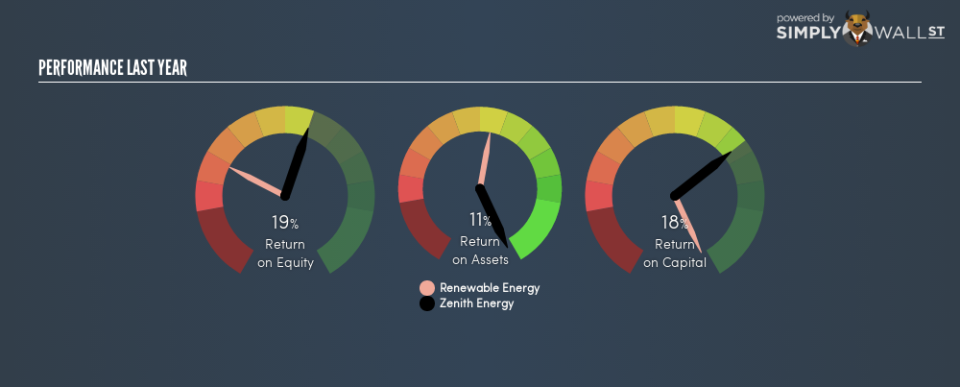Zenith Energy Limited (ASX:ZEN) Is Employing Capital Very Effectively

Today we’ll look at Zenith Energy Limited (ASX:ZEN) and reflect on its potential as an investment. Specifically, we’re going to calculate its Return On Capital Employed (ROCE), in the hopes of getting some insight into the business.
First, we’ll go over how we calculate ROCE. Next, we’ll compare it to others in its industry. Finally, we’ll look at how its current liabilities affect its ROCE.
Return On Capital Employed (ROCE): What is it?
ROCE is a measure of a company’s yearly pre-tax profit (its return), relative to the capital employed in the business. Generally speaking a higher ROCE is better. Overall, it is a valuable metric that has its flaws. Author Edwin Whiting says to be careful when comparing the ROCE of different businesses, since ‘No two businesses are exactly alike.’
So, How Do We Calculate ROCE?
The formula for calculating the return on capital employed is:
Return on Capital Employed = Earnings Before Interest and Tax (EBIT) ÷ (Total Assets – Current Liabilities)
Or for Zenith Energy:
0.18 = AU$14m ÷ (AU$96m – AU$19m) (Based on the trailing twelve months to June 2018.)
So, Zenith Energy has an ROCE of 18%.
Check out our latest analysis for Zenith Energy
Want to help shape the future of investing tools and platforms? Take the survey and be part of one of the most advanced studies of stock market investors to date.
Is Zenith Energy’s ROCE Good?
ROCE can be useful when making comparisons, such as between similar companies. Using our data, we find that Zenith Energy’s ROCE is meaningfully better than the 8.9% average in the Renewable Energy industry. We consider this a positive sign, because it suggests it uses capital more efficiently than similar companies. Separate from Zenith Energy’s performance relative to its industry, its ROCE in absolute terms looks satisfactory, and it may be worth researching in more depth.
Zenith Energy’s current ROCE of 18% is lower than 3 years ago, when the company reported a 47% ROCE. So investors might consider if it has had issues recently.
When considering ROCE, bear in mind that it reflects the past and does not necessarily predict the future. ROCE can be deceptive for cyclical businesses, as returns can look incredible in boom times, and terribly low in downturns. This is because ROCE only looks at one year, instead of considering returns across a whole cycle. How cyclical is Zenith Energy? You can see for yourself by looking at this free graph of past earnings, revenue and cash flow.
Do Zenith Energy’s Current Liabilities Skew Its ROCE?
Liabilities, such as supplier bills and bank overdrafts, are referred to as current liabilities if they need to be paid within 12 months. The ROCE equation subtracts current liabilities from capital employed, so a company with a lot of current liabilities appears to have less capital employed, and a higher ROCE than otherwise. To check the impact of this, we calculate if a company has high current liabilities relative to its total assets.
Zenith Energy has total assets of AU$96m and current liabilities of AU$19m. As a result, its current liabilities are equal to approximately 20% of its total assets. Low current liabilities are not boosting the ROCE too much.
The Bottom Line On Zenith Energy’s ROCE
Overall, Zenith Energy has a decent ROCE and could be worthy of further research. Of course you might be able to find a better stock than Zenith Energy. So you may wish to see this free collection of other companies that have grown earnings strongly.
I will like Zenith Energy better if I see some big insider buys. While we wait, check out this free list of growing companies with considerable, recent, insider buying.
To help readers see past the short term volatility of the financial market, we aim to bring you a long-term focused research analysis purely driven by fundamental data. Note that our analysis does not factor in the latest price-sensitive company announcements.
The author is an independent contributor and at the time of publication had no position in the stocks mentioned. For errors that warrant correction please contact the editor at editorial-team@simplywallst.com.

 Yahoo Finance
Yahoo Finance 
